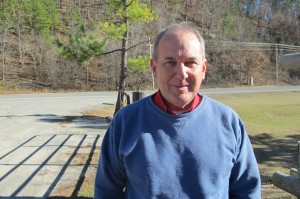
Ed Brocksmith, co-founder of the advocacy group Save the Illinois River, says clearer water doesn't mean the poultry industry should be off the hook.
Logan Layden / StateImpact Oklahoma


Ed Brocksmith, co-founder of the advocacy group Save the Illinois River, says clearer water doesn't mean the poultry industry should be off the hook.
Logan Layden / StateImpact Oklahoma

Logan Layden / StateImpact Oklahoma
Ed Brocksmith, co-founder of the advocacy group Save the Illinois River, says clearer water doesn't mean the poultry industry should be off the hook.
Former State Attorney General Drew Edmondson filed a lawsuit against the Arkansas poultry industry in 2005.
His claim: Chicken waste was polluting the Illinois River with phosphorous. Arguments ended in 2009. Since then: nothing. The judge still hasn’t ruled.
The lawsuit was one of the many ways the state has tried to address this issue.
“You bet we’re frustrated. There’s been one study after another of pollution in this watershed. And yet the studies are still going on,” says Ed Brocksmith, co-founder of the advocacy group Save the Illinois River. “We’re frustrated because Oklahoma had a viable phosphorous limit for state scenic rivers, yet the state has turned around and put that limit in jeopardy by allowing this new study.”
The new study Brocksmith is talking about is a partnership between Oklahoma and Arkansas to determine whether phosphorous pollution goals established in 2002 are viable. But Ed Fite, administrator of the state Scenic Rivers Commission, traces the history of the pollution much further back — and beyond chicken farms.
“The headwaters of the Illinois River Basin is where Walmart is located. It’s where the major poultry industry is located. It’s where J.B. Hunt Trucking and some other large industries have set up shop,” Fite says. “There were less than 200,000 people in the basin in the ’70s.”
Today the basin is home to about 600,000 people, and Fite says that rapid growth is hard on the river.
“When folks really started realizing that the Illinois River wasn’t as pristine as it was was in the early ’80s,” Fite says. “There was abundant algae growth — had all these nuisance types of algae that were occurring. And it was evident that something was going wrong.”

Logan Layden / StateImpact Oklahoma
Oklahoma Scenic Rivers Commission Administrator Ed Fite outside the OSRC office near Tahlequah, Okla.
Oklahoma has been pushing to limit phosphorous pollution ever since, including an attempt that led to a U.S. Supreme Court ruling in 1992 over discharges from Fayetteville’s water treatment plant.
But the state’s chronic courtroom disappointments haven’t kept progress from being made.
Brocksmith stands at the bank of the Illinois River near Tahlequah, and describes the algae blooms when they were at their worst.
“The rocks were actually green and slimy. And there was a particular type of algae that locals all ‘horse snot algae’ that was long strands,” Brocksmith says. “And now, especially after a really heavy rain, the rocks in the river are sparkling bright, and white, and the river is just crystal clear.”
Oklahoma might not have won its Supreme Court fight with Fayetteville, but that city, and growing communities across the watershed improved their water systems and started treating for phosphorous.
Fite says poultry companies are feeling the pressure, too, thanks to the 2005 suit.
“The poultry industry — since that lawsuit — has been moving out about 80 percent of the poultry waste plus out of the basin,” Fite says.
He’s not sure if there will ever be a ruling on the 2005 lawsuit, especially if Arkansas and Oklahoma can finally work out a phosphorous pollution limit on their own, and given the improvements that have already been made.
Until then, Fite hopes the poultry companies’ apparent good faith efforts continue.